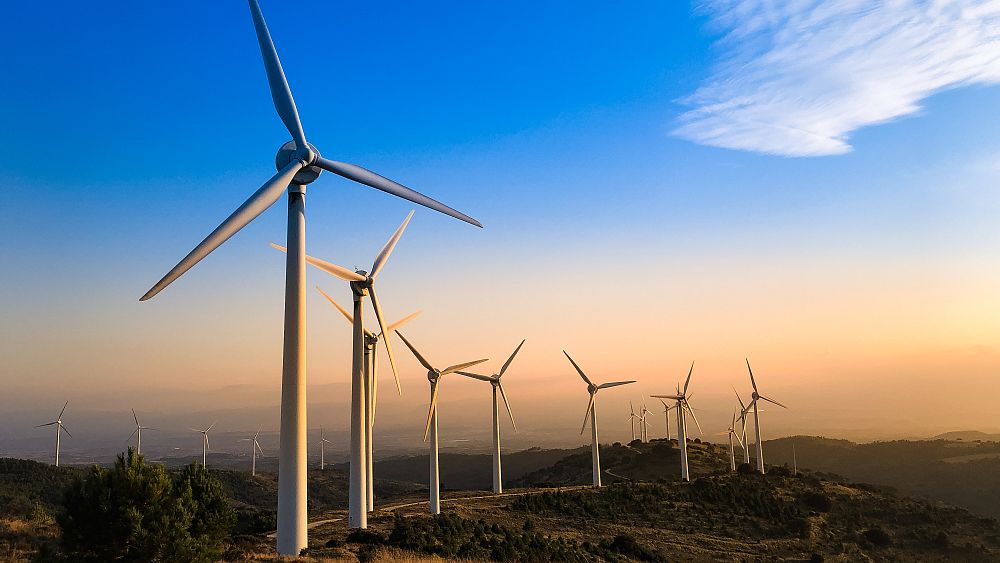Last year saw a record number of wind energy installations across Europe, although still below what is needed to reach the European target of 40% renewable energy by the end of this decade. Nevertheless, the rush towards energy independence and the 236 GW currently installed and the 116 GW (source: Wind Europe) planned for the next four years testify to the European ambition to revive wind power. But how can the industry maintain these high ambitions when the winds are low?
Wind droughts – a new challenge for the European energy system?
In 2021, in parts of northwestern and central Europe, wind speeds were unusually low, with some of the lowest speeds recorded in the past 40 years throughout the summer, according to the Copernicus Climate Change Service (C3S). In some places in the UK, Czech Republic, Ireland, Germany and Denmark, annual wind speeds were even 10% lower than averages for the past 30 years, according to C3S data.
Figure 2. (Left) Annual average wind speed anomalies at 100 m in 2021, compared to the reference period 1991-2020, by country. (Right) Time series of annual mean 100m wind speed anomalies for the five countries with the largest negative anomaly in 2021. In all graphs, anomalies are expressed as a percentage of the mean for the reference period 1991-2020. Data source: C3S Climate and energy indicators for Europe from CRE5.
“There have been prolonged periods of high pressure in the North Atlantic around Europe,” says Dr Hannah Bloomfield, a climate risk researcher at the University of Bristol, UK. “These are conditions that normally lead to weak winds, we call them blocking events, when these high pressure air masses stay there,” says Dr Bloomfield, who adds that the UK has repeatedly recorded such blockages last summer. Scientists call these droughts wind, and although they are not as dramatic as storms or tornadoes, they are still considered an extreme weather event.
Although last year’s wind drought is primarily associated with climate variability according to Dr Bloomfield, it is also important to note that climate change may play a role in influencing long-term wind patterns. But depending on the climate scenario, the wind speed can increase or decrease. The IPCC Sixth Assessment Report suggests that there is an 8 in 10 chance that medium wind speeds over the Mediterranean region of Europe will decrease, and about a 5 in 10 chance of this happening in Northern Europe if global temperatures increase by 2 degrees beyond 2050. Dr Bloomfield explains that this could occur as the Arctic warms to a much higher level. faster speed than lower latitudes, reducing temperature differences that influence wind behavior. In other words, the smaller the temperature differences, the weaker the winds.
The energy output of a wind turbine is directly related to the cube of the wind speed. In other words, the change in wind speed becomes a threefold change in energy output. Because of this relationship, even a small change in wind speed can have a major impact on the electricity sector and therefore on Europe’s ability to build its renewable wind portfolio.
Figure 3. Annual wind capacity factor (CF) anomalies by country in 2021, relative to the 1991-2020 baseline, for onshore (left) and offshore (right) wind power generation. Anomalies are expressed as a percentage of the 1991-2020 average. Data source: C3S Climate and energy indicators for Europe from CRE5.
Weak winds last year caused Britain, Germany and Denmark to use just 14% of their installed wind capacity between July and September, down from the usual 20-26% in previous years, according to Reuters. In the first half of last year, especially in Germany, wind energy production was 25% lower (46.8 TWh) compared to the same period of 2020 (59.4 TWh), according to a Forbes report, further pushing demand towards fossil fuels. power plants and increase the country’s carbon emissions from electricity by 25%.
Manage variability
According to Wind Europe, the association for the promotion of wind energy, the episode of weak winds is not necessarily surprising, and the shortage in summer has been compensated by winter winds. “There are always slight differences in the wind resource from one year to the next”, explains Christoph Zimpf, press and communication manager at Wind Europe. “2021 was slightly lower than 2020 which had been an extremely good windy year with strong spring winds. For most of last year, it looked like 2021 would end as a pretty poor wind year, but storms in November and December boosted the full-year generation result. It landed in the expected band of year-over-year variation.
Being able to weather these dry spells remains important for the renewables industry to step up and help Europe quickly end its dependence on oil and gas. On May 18, the European Commission published its REPowerEU action plan in political response to Russia’s invasion of Ukraine. “The Commission is crystal clear that overreliance on fossil fuel imports from Russia and elsewhere must end,” Zimpf says. Massive expansion of domestic renewables is one of the three pillars of the plan, Zimpf says, along with finding new sources of energy imports and improving energy efficiency. “Wind energy is at the heart of this […]. By 2050, the Commission wants wind to account for 50% of all electricity used in the EU. Today it’s 15%,” says Zimpf. “In the medium term, wind power is expected to accelerate significantly and help replace imported fossil fuels. To this end, the European Commission wants to increase the EU’s installed wind capacity from 190 GW today to at least 480 GW by 2030.”
Brussels’ announcement was followed by Germany, Denmark, the Netherlands and Belgium who signed a 150 billion euro agreement to build at least 150 GW of offshore wind installations by 2050. With so many plans on the table and with the REPowerEU plan designed to shorten the red tape for wind project approvals, improving the efficiency of wind power generation in the face of climate variability is attracting more and more attention.
“The wind drought that affected most of Central and Western Europe in 2021 shows the importance of climate data in managing our energy mix,” says Dr Carlo Buontempo, Director of C3S. “Understanding how likely these events are and whether their frequency is likely to change will become of greater importance as installed capacity for renewables increases. Recent observations and current forecasts have not significantly changed the potential for increased wind power generation in Europe. They just made it more obvious that there are certain vulnerabilities and risks that need to be managed. The data and tools provided by C3S will help industries and policy makers in such a process. »
Dr Bloomfield says predicting long-term weak winds remains tricky, although many scientists are producing data sets that can help the wind power industry better adapt in the future. “It has become easier to do long-term risk assessments for wind power sites. I think the industry could really benefit from the energy weather community,” says Dr Bloomfield. “Being open and coming to organizations like Copernicus with their issues could be very helpful in guiding the scientific community to look at issues that are relevant to industry.” Wind power producers can develop ways to integrate scientific observations and predictions when making decisions, which will help manage the challenges of climate variability, says Dr Buontempo.
Despite losses in wind power generation last year, countries have managed to find other energy sources to fill the gap. Germany has tapped into its solar power, while the UK has used its links to energy systems in France and Norway to boost production. With such variability to manage, wind plays an important role in the European renewable energy portfolio, but is not the only player, as Wind Europe suggests. “Overall, the renewable energy system of the future of Europe will need all renewable energy sources […]says Zimpf. “Wind and solar are natural partners: wind power generation is typically highest in autumn, winter and spring – and rather low in summer, just when solar power generation peaks. maximum. In this sense, the two technologies are complementary. However, to achieve higher shares of renewables in the energy system, they will need to be linked to battery storage and other storage media such as renewable hydrogen. Both technologies are rapidly reducing costs and will soon be widely available. »




